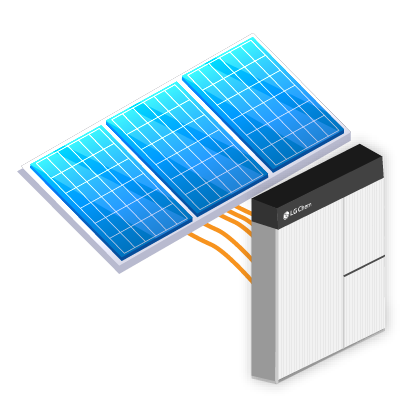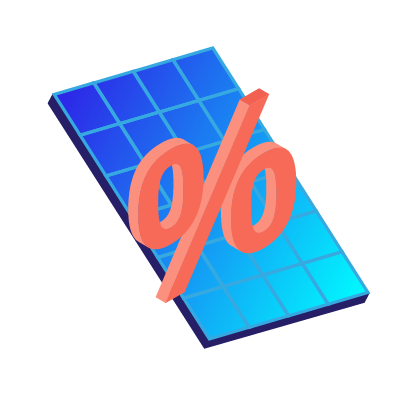The Value of Custom Designed Solar Systems
When customers come to us from other installers, they are always hesitant and anxious. Why? Because when you go straight to the installer they give you general pricing and tell you how your system is going to look and produce.
Not at Solar.com. We find out all your needs and then give the installer a layout they need to follow ensuring all your needs are met at the lowest possible price.
Solar.com uses a remote design program, in addition to a number of sophisticated tools which are used to make your design as accurate as possible. Structural, environmental, electrical, aesthetic and policy factors are all considered.
Roof Tilt and Orientation
Unless you are going to restructure your roof, the pitches and direction that your roof planes are facing are not something that can be changed. The pitch and orientation are the two biggest factors in determining how much solar energy is available at your location.
Solar panels absorb more energy from the direct sunlight, meaning panels that directly face the sun produce more electricity. Some setups have tracking systems that move panels throughout the day and the year to match the sun’s movement and get the highest production possible.
These systems are impractical on residential roofs as they are more expensive and produce little additional energy at residential system sizes. Therefore, the fixed location of the panels in a residential design is important. Panels with a steeper tilt do better at higher latitudes (Alaska, Maine, Washington, etc.), closer to the poles, as the sun is lower in the sky for longer periods during year.
Inversely, the closer your home is to the equator, the lower the ideal tilt angle and roof pitch. Panels can be tilted off the roof, but for all roof surfaces that are not flat roofs, this is impractical. If your home is in the northern hemisphere, the orientation of best production is due south, where your panels will get the most direct solar radiation over the day.
Shade
Some sources of shade on your roof may also be unchangeable factors. Your neighbors’ homes, for example, may shade your house in the morning or evening. Likewise, trees that are not on your property can still provide significant sources of shade to portions of your roof depending on their height and proximity to your home.
Trees on your property are a little more manageable. Many solar customers do not have to alter or remove their trees in order to have an effective solar system, but occasionally the removal of one or more trees means the difference between a home being able to go solar and not. Custom designs can be made to either include or exclude crucial trees or other obstructions.
Fire Setbacks
For fire safety, many states, counties, and municipalities have fire regulations that require that solar not be installed in certain areas to aid firefighters in the event of a fire in your home. These are called fire setbacks and they require that significant portions of your roof surfaces near the ridges, along hips and valleys, and up the edges of your roof have to be left clear for emergency walkways.
Not all areas require the same setback distances, and the inclusion of these setbacks significantly changes the available area for solar.
Roof Obstructions
Roof surfaces can have a variety of obstructions such as skylights, air conditioning units, vents of various shapes, chimneys, and others. Most roof obstructions are assumed to be immovable and are given a six-inch buffer from solar panels.
Vents that do not heat producing can be changed to be flat and paneled over or moved to another area to facilitate a bigger or more aesthetic panel arrangement.
Aesthetics
The most efficient layout for production is not always the best looking. Generally, regularly shaped arrays and arrays with panels that are all landscape or portrait on the same roof plane are ideal, but that is not always possible due to roof obstructions or the required number of panels to meet the production value.
In addition, there may be a homeowners’ association that requires that panels not be placed on areas facing a street, that only all-black panels be used or other aesthetic restrictions. Some states do restrict HOAs from cumbersome regulations. You as a homeowner may have aesthetic restrictions that may not produce the most electricity but will look pleasing on your home.
System Sizing
The size of the system depends on two things: the usage at the home that is being met and the production of the panels. Usage is calculated  from your bills. If you will be in a tiered utility structure, then a simple bill with your annual usage will be enough to estimate how much needs to be offset.
from your bills. If you will be in a tiered utility structure, then a simple bill with your annual usage will be enough to estimate how much needs to be offset.
If solar will change you to a time-of-use (TOU) structure, then the size of the system may not be directly related to the usage and requires detailed hourly interval data.
TOU usage depends on when you use energy as energy will cost more at peak times and seasons.
Likewise, the energy produced at peak times and seasons is worth more. In California, for example, the major utilities structure their rates to have peak times during the summer and in the afternoon and evening. Thus, it can be more beneficial to have a solar array that faces west or southwest.
The total energy produced is less, but the credit given for the energy produced is worth more, so it can be a more effective design.
Why You Should Trust Solar.com For Your System Design
Solar.com uses satellite imagery and sophisticated design software to model your home. The pitch of your roof can be determined from mathematically comparing overhead images to street views or through light detections and ranging (LiDAR) data which accurately shows the pitch of roofs as well as the height of homes and trees.
The same software also computes annual sun paths and provides detailed solar availability across all roof surfaces and takes into account the shade from roof obstructions, trees, other homes, and even self-shading from levels in your own home.
Your custom design will be sure to include all the factors above to provide an accurate estimation of your solar needs.
See how much you can save with Solar.com, here!











